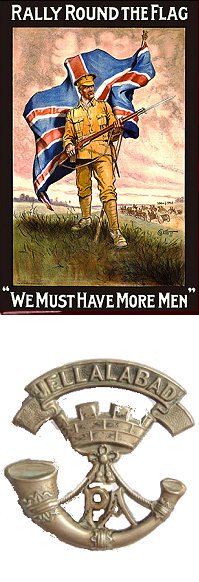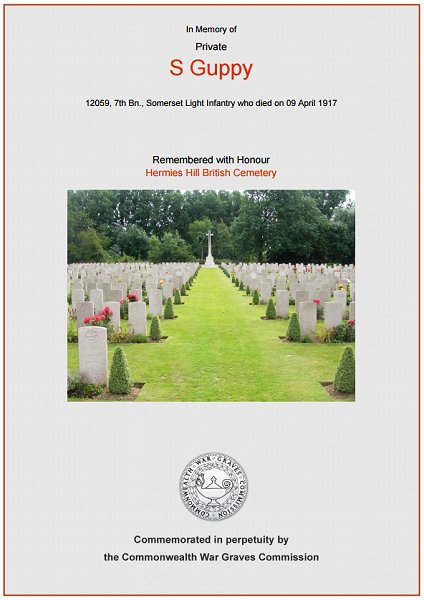yeovil at War
Sidney Guppy
Killed in action on the first day of the Second Battle of Arras
Sidney Guppy was born in Yeovil in 1880, the youngest child of agricultural labourer Samuel Guppy (1816-1886) and his second wife Lucy née Sherman (1836-1912). Samuel had two children from his first marriage to Mary Ann née Cupper (1817-1856); Ann (1850-1883) and John (b1854). After the death of his first wife Sidney married Lucy at Yeovil in the autumn of 1858. They were to have nine children although only five would survive beyond childhood; William (b1867), Thomas (b1869), Samuel (b1872), Edward (b1876) and Sidney.
In the 1881 census Samuel and Lucy, together with their four youngest sons, were living at 29 Park Street, next to the Cross Keys Inn. Samuel gave his occupation as an agricultural labourer and Lucy gave hers as a glover.
In the summer of 1886 Samuel Guppy died in Yeovil, aged 70. During the winter of 1890 40-year old Lucy married painter and paperhanger Charles Walton at Yeovil. In the 1891 census 11-year old Sidney was living at 36 Park Street with Charles and Lucy although for an unknown reason he was listed as their grandson. He was working as a butcher's boy. In the autumn of 1899 Sidney's step-father Charles Walton died aged 58.
In the 1901 census, while his mother Lucy was living on her own in Park Street, 21-year old Sidney was boarding at Wrington, Somerset, with the family of stonemason Edward Dingley and his family. Sidney gave his occupation as a bricklayer. By the time of the 1911 census Sidney was back at home with his mother in Park Street, still giving his occupation as a bricklayer. However during the winter of 1912 Lucy died, aged 76, leaving Sidney on his own.
 It
is not known
when Sidney
enlisted
although he
enlisted at
Yeovil, joining
the 7th
(Service)
Battalion,
Somerset Light
Infantry. His
Service Number
was 12059.
It
is not known
when Sidney
enlisted
although he
enlisted at
Yeovil, joining
the 7th
(Service)
Battalion,
Somerset Light
Infantry. His
Service Number
was 12059.
Nothing is known of Sidney's military career except that he took part in the Second Battle of Arras which saw the involvement of all the Somerset battalions in France at that time.
The Second Battle of Arras, fought between 9 April and 16 May 1917, was the British contribution to the Allied spring offensive of 1917. The original Allied plan for 1917, agreed at the Chantilly conference of November 1916, was for a second offensive on the Somme, but that plan was abandoned after a change of French leadership and it was decided that the British would attack around Arras and involve troops from three armies. In the north the Canadian corps of the First Army would attack Vimy Ridge. In the centre of the line the Third Army under General Allenby would attack from Arras. Finally, the British Fifth Army under General Gough would attack on the right of the line. The entire British attack was supported by 2,879 guns each of which had close to 1,000 shells. The British attack made impressive progress, but it did not achieve a breakthrough on the first day, allowing the Germans to rush their reinforcements into the gap and launch a series of counterattacks thereby slowing down the British attack.
Sadly Sidney was killed in action on 9 April 1917, the first day of the Second Battle of Arras. He was 37 years old. He was buried in a temporary grave marked with a cross but later exhumed and buried at Hermies Hill British Cemetery, Pas de Calais, France, Grave IV.E.12.
His name was added to the War Memorial in the Borough in 2018.
gallery

The Commonwealth War Graves Commission certificate in memory of Sidney Guppy.